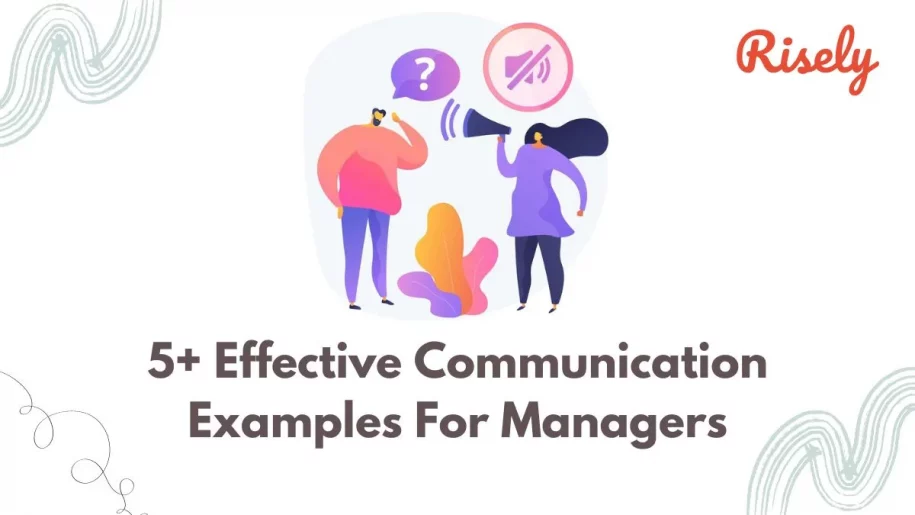5+ Effective Communication Examples For Managers
Effective communication is at the core of every good team. Effective communication skills are crucial for managers to manage their teams and drive performance powerfully. Managers need these skills to be effective communicators in their teams and elsewhere. Effective communication can positively impact team morale, work quality, and employee engagement. This blog will cover effective communication examples for managers that you can use in your workplace to build strong communication practices that will benefit your team. So keep reading till the end to find free resources for improving communication skills as a manager.Effective Communication In The Workplace
Effective communication in the workplace stands for the process of exchanging information, thoughts, and ideas clearly with others. It helps enhance transparency, shares information, and is a tool for building consensus across teams. Communication is effective when it follows the seven fundamental principles that make quality. Effective workplace communication improves team productivity and cohesion and makes it easier for employees to get things done. When communicating with colleagues, it is important to be clear and concise and to keep the discussion on task. It is also helpful to provide context and background information when discussing topics unfamiliar to others. Finally, avoiding personal attacks and gossip is essential, which can negatively affect team morale and productivity.Effective communication examples in the workplace for managers
A manager taking regular check-ins with their team
A manager schedules a weekly meeting with their team to discuss project progress, address any obstacles, and gather input. The manager actively listens, clarifies, summarizes team members’ points, and provides clear instructions. This open and transparent communication fosters a positive work environment, improves teamwork, and ultimately leads to successful project outcomes. The meeting also allows team members to ask questions, provide updates and feel heard, creating a sense of trust and accountability. This type of effective communication sets clear expectations and creates a culture of collaboration and mutual respect.Managers who lead by example
A team leader sends regular updates via email or team chat, keeping everyone informed of project progress, upcoming deadlines, and any changes in plans. This type of communication ensures everyone is on the same page and reduces the chance of misunderstandings or missed deadlines. In addition, by proactively communicating project status and changes, the team leader fosters trust and accountability, and the team can work more efficiently and effectively.Taking communication to the individual level
A manager holds one-on-one meetings with each team member to discuss their individual goals, performance, and any concerns. This type of personalized communication provides an opportunity for open and honest feedback and addressing any issues before they become more significant problems. Regular one-on-ones also help to build strong relationships between the manager and team members, fostering a supportive and productive work environment.Communicating for seamless collaboration
A team collaborates using shared documents and project management tools, allowing for clear task assignments, updates, and communication of ideas and feedback. By centralizing communication and task tracking, the team can quickly identify any roadblocks and make necessary adjustments, leading to a more streamlined and efficient workflow. This type of collaboration also fosters transparency and accountability and helps to ensure everyone is working towards the same goals.Building culture through effective communication:
A company implements an open-door policy, encouraging employees to speak with their managers and HR about any issues or concerns, promoting transparency and a positive work environment. This communication builds trust and fosters a culture of openness and respect, allowing employees to feel heard and valued. The open-door policy also will enable managers to address workplace issues before they escalate, improving morale and overall productivity.Other Interesting Reads
Effective communication in the workplace examples from real life
You can find effective communication in the workplace examples from real life everywhere. Of course, you see them on social media and in movies, but effective communication is no joke. Therefore, it’s of vital importance to have good communication skills in the workplace, and some managers show us exactly how it is done:The case of HubSpot
HubSpot sets benchmarks for building transparency in teams through its policy that always welcomes questions. Started by co-founder and CTO Dharmesh Shah, with the title of “Ask Dharmesh Anything,” the approach makes upper management more accessible to employees. Anyone from the workforce can put questions for the CTO to answer. A culture open to discussion and deliberation is a great asset for an organization that runs on creativity. Effective real-life communication examples have shown the impact of building healthy communication practices in workplaces.Innovation at Microsoft Services Asia
Microsoft Services Asia, with its humungous workforce, came up with an exciting idea to break free from the limitations set by conventional communication channels. So they started weekly video podcasts that came up every Friday. Titled ‘Five-minute Fridays,” the little bites shared updates, information, and achievements of the week. In return, the employees share their feedback and participate in future iterations of the podcast. But it goes the other way too! Effective real-life communication examples are great, but general corporate trends can make them hard to spot. Often, insufficient attention is paid to team communication, leading to dissatisfied employees. For example, it was recently seen in the insensitive manner of conducting layoffs adopted by many organizations. As an employee is undergoing the difficult circumstances of a layoff, the abrupt manner of communication can further worsen their case. Many employees found themselves laid off through mass-sent emails, displaying little concern for the individual on the part of the organization. It led to chaos without clarity on the reasons and the decision itself, indicating ineffective communication practices adopted by those teams. Managers need to ensure that effective communication is a habit that sticks all year round. Moreover, a manager can take steps to rebuild communication in their teams after they have also faced layoffs.How to build effective communication practices?
- Establish clear communication goals and objectives: Ensure that all team members understand the company’s communication strategy, as well as their role within it. It will help them stay on track and be better at fulfilling their responsibilities.
- Make communication a priority: Ensuring everyone knows what to do when unexpected situations arise is key to effective communication practices. Maintaining clarity throughout complicated scenarios will make life easier for everyone involved- not just those who need the info ASAP!
- Make listening important: Take time to listen attentively to others, even if you don’t have all the answers. This crucial skill will help you to understand their concerns and build a strong relationship with them.
- Make communication feedback effective- Ensure that any communication feedback is delivered properly so that team members can take it to heart and improve their communication skills in the future. Feedback should be constructive yet clear- allowing team members to learn from their mistakes while maintaining respect for one another.
- Grow your and your team’s communication skills with Risely: Risely helps managers beat ineffective communication and 30+ other challenges that make people management tough. Discover your true potential today by signing up for Risely for free and taking charge of your growth.
Conclusion
Effective communication is vital in any workplace, and it is essential that managers embrace the art of listening more than they speak. By listening to employee feedback and concerns, ensuring a supportive environment, and building trust and communication skills, managers can support their teams to be more creative and productive. The effective communication examples listed in the blog above will inspire you to communicate and create more!Are your communication skills effective? Test for free now
Take the free communication skills assessment to understand what makes your communication weak
Other Related Blogs
Executive Communication Coach: When And How To Choose
Executive Communication Coach: When And How To Choose Good communication is a must for professional success. After all, half of people management is all about saying the right things in…
5 Unique Benefits Of Online Leadership Coaching
5 Unique Benefits Of Online Leadership Coaching Remember the days of leadership development being confined to a stuffy conference room filled with flipcharts and generic advice? Yeah, those days are…
Performance Management Training: Empowering Managers To Manage Better
Performance Management Training: Empowering Managers To Manage Better Remember that feeling of dread when you knew performance review season was rolling around? Yeah, us, too. For many employees, performance reviews…
Manager Development Goals And How To Reach Them: Opportunities And Areas To Focus On
Manager Development Goals And How To Reach Them: Opportunities And Areas To Focus On You’ve meticulously crafted a development program for your high-potential employees, but their managers just aren’t on…


